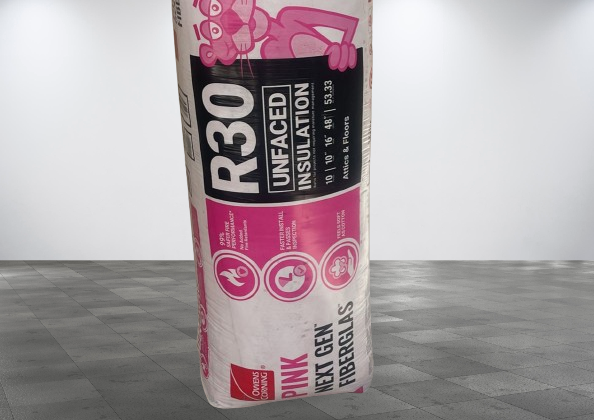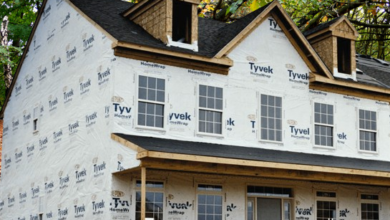R-30 Insulation for 2x6 Ceilings

R-30 insulation is required by local building codes in certain areas. This is fantastic news since it means that the residents will have more comfortable interior temperatures and pay less in energy bills due to the relatively high R-value.
It is nearly impossible to achieve an R-30 insulation rating if your ceiling is 2×6. Therefore, if you’re wondering what to do next after finding yourself in such a situation.
I’ll go over everything you should know about R-30 insulation for ceilings that are 2×6.
Would R-30 Insulation Work Well With A 2×6 Ceiling?
Regretfully, there is a reason why an R-30 insulation isn’t the best choice for a 2×6 ceiling. Most R-30 insulations have a thickness of 10 inches, according to your observation.
There is only 5.5 inches of space available in a 2×6 ceiling. That’s a blatant sign, then, that the insulation won’t fit the 2×6 ceiling.
You could compress the insulation to make it fit. However, you must be aware that insulation loses its thermal resistance when it is compressed.
Compressing the air pockets in insulation results in a significant reduction in its energy efficiency. Hence, you won’t ultimately receive the R-30 value that you had predicted prior to installation.
What Kind Of Insulation Is Suitable For A 2×6 Ceiling?
You must look into other options because an R-30 insulation won’t fit your 2×6 ceiling without compression. And R-19 insulation is the best option for a ceiling like that.
I am aware of how much lower this R-value is than the R-30. However, R-19 insulation can easily fit a 2×6 ceiling snugly. For 2×6 walls, R-19 insulation is advised.
6.25 inches of insulation make up an R-19. Compared to a 2×6 ceiling, it is 0.75 inches thicker. Thus, this insulation will compress by 0.75 inches when applied to your ceiling. As a result, you will receive an actual R-value of 18, which is a very small variation.
As an expert, I would suggest that you use R-19 insulation rather than R-30 insulation for your 2×6 ceiling. I know that the latter is more heat resistant than the former.
However, you will need to compress it in order to install it, which will negatively impact its efficiency. It is preferable to have insulation that fits precisely and doesn’t compress.
Does R-30 Insulation’s Performance Change When Compressed in a 2×6 Ceiling?
As previously stated, compressing the insulation is the only way to fit R-30 insulation on a 2×6 ceiling. But doing so has a significant impact on how well it performs. Permit me to walk you through the insulation process in brief.
Air pockets in insulation stop heat from transferring from one side to the other. These air pockets contract when the insulation is compressed, which lessens its capacity to keep heat from escaping. That first R-value won’t matter.
Compressed R-30 insulation is very ineffective in a 2×6 ceiling. For this reason, I have suggested using R-19 as a substitute. Only 2×10 ceilings should use R-30 insulation.
Therefore, you can increase the thickness of your ceiling boards to measure 2×10 instead of 2×6 if you must use R-30. Please be aware that doing so will take up space on your ceiling.
What Advantages Do R-30 Insulation In 2×6 Ceilings Offer?
The advantages of having an R-30 insulation on a 2×6 ceiling would be numerous. The following are some advantages of using R-30 insulation for a 2×6 ceiling:
- Unmatched Indoor Comfort: Given that this R-value is extremely high, owners with R-30 insulated ceilings ought to have very good thermal comfort.
- Better Energy Efficiency: Your home’s increased resistance to heat flow means that your HVAC systems won’t need to run as hard to keep the interior at a comfortable temperature. As a result, utility bills are lowered and energy consumption is decreased.
- Quieter Interior: An R-30 insulation on a 2×6 ceiling can lessen outside noise, like traffic or neighboring music, while still providing superior thermal resistance.
- Adherence to Local Codes: As previously indicated, ceilings in certain places must have R-30 insulation. You wouldn’t have to worry about breaking local building codes or failing an inspection if you could fit such on your 2×6 ceiling.
- It Can Raise the Value of Your Home: Did you know that something as easy as insulating your ceiling with an R-30 can raise the value of your home when it comes time to sell? This is an investment that may end up being profitable in the future.
Exist Any Local Building Codes That Demand R-30 Insulation Be Installed In Place of a 2×6 Ceiling?
Local building codes differ from place to place. Certain local laws may stipulate that all ceilings must have R-30 insulation installed. The interests of the locals are typically the first priority for these laws.
For example, such an R-value provides better energy efficiency because certain zones have extreme climates. But in some situations, like those where someone has a 2×6 ceiling, this kind of insulation won’t work.
For this reason, I consistently counsel my readers to become well-versed in all aspects pertaining to the building codes in their area.
Check to see if you are aware that R-30 insulation is required by local laws in your area. Instead of building a 2×6 ceiling, which can only hold R-19 insulation, you would have built a 2×10 ceiling.
However, you can always go to the appropriate department and present your case there before making a decision.
Since inspectors are also people, they are able to empathize with your situation and approve the use of the advised insulation on a 2×6 ceiling.
Is It Possible To Enhance The Effectiveness Of Compressed R-30 Insulation In A 2×6 Ceiling?
If you choose to utilize R-30 insulation on a 2×6 ceiling and compress it, there are a few more tools and methods that can help it work better. Among them are
- The outside side of the ceiling can have insulating sheathing added to it. This will maximize interior headroom and improve the R-value overall.
- Adding another radiant barrier can also aid in the sun’s heat reflection.
- Check for leaks and seal them completely to make sure no heat escapes on the sides. There are numerous sealants available that are capable of completing this task.
- Changing to energy-saving bulbs is another way to increase interior energy efficiency.
However, this seems like a lot of work, doesn’t it? Would you not prefer R-19 insulation that fits perfectly and works at its best?
Give it some thought and determine if the R-30 insulation and the aforementioned materials are appropriate for a 2×6 ceiling.
What Consequences Come With Installing R-30 Insulation In A 2×6 Ceiling?
Here are some common disadvantages of using R-30 insulation on a 2×6 ceiling to show you why it’s not a good idea to do so:
- There won’t be adequate room for the insulation. The largest obstacle and setback is this.
- An R-30 insulation may take up some headroom due to its thickness. It’s likely that you need as much space as possible if this is an attic.
- You might run into issues with upgrades in the future if you use R-30 insulation.
- The cost of materials will increase if you choose to use more in order to improve performance.
- There is greater opportunity for error when using incompatible materials.

